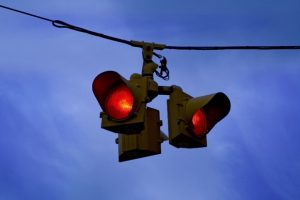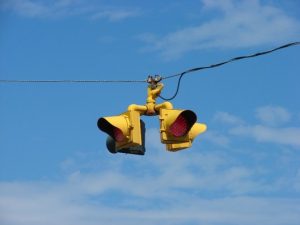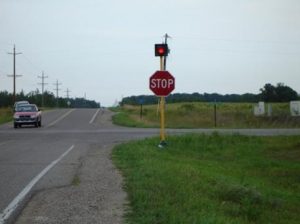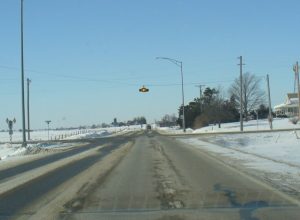Flashing Beacons
Flashing beacons supplement stop signs and are intended to reinforce awareness of existing stop signs.
Description

Beacons are flashing lights intended to draw a driver’s attention towards the associated traffic control.
Flashing beacons supplement stop signs and are intended to reinforce awareness of existing stop signs. Two different types of intersection beacons are typically used, including standard overhead beacons mounted over the intersection and sign-mounted beacons that may be mounted on the stop sign or stop ahead and intersection ahead signs.
Placement

- Standard overhead beacons include:
- Red flashers placed facing the stop-controlled approach and yellow flashers placed facing the unstopped approaches for two-way stop controlled intersections
- Red flashers placed to face all approaches at all-way stop controlled intersections (Antonucci et al. 2004)
- May be most effective at intersections with patterns of right angle crashes related to lack of driver awareness
- Needs to be properly placed so that beacon is visible to drivers on corresponding approach
Effectiveness
Several studies have evaluated the effectiveness of beacon installation.
The following table summarizes the studies where crash reductions were found.
Crash Reduction for Installation of Intersection Flashing Beacons
| Studies | Loc. | # of Sites | Beacon Type | Crash Type | Change in Crashes |
|---|---|---|---|---|---|
| frontal impact | -9% | ||||
| severe injury | -40% | ||||
| injury | -9% | ||||
| Murphy and Hummer 2007 | NC | 34 | standard overhead | total | -12% |
| angle | -19% | ||||
| Pant et al. 1992 | OH | 7 | standard overhead | fatal | -56% |
| 5 | stop sign | angle | -58.2% (16.3) | ||
| Srinivasan et al. 2008 | NC and SC | 84 | standard overhead | angle | -11.9% (5.4) |
| 4 | stop sign and intersection ahead signs | total | -40% | ||
| Stackhouse and Cassidy 1996 | MN | 8 | standard overhead | total | -39% |
| Brewer and Fitzpatrick 2004 | TX | 4 | standard overhead | prevent -able | -43% |
| ran stop sign | -26% |
Advantages

- Sign mounted beacons may be added to existing sign post
- Can be implemented in a reasonable time frame
Disadvantages
- Requires power source
- Overhead requires support structure
More information is provided in this technical brief, Flashing Beacons (PDF), which summarizes information about flashing beacons relevant to Iowa.

References
Antonucci, Nicholas D., Kelly K. Hardy, Kevin L. Slack, Ronald Pfefer, Zikhron Yaacov, and Timothy R. Neuman. Volume 12: A Guide for Reducing Collisions at Signalized Intersections.NCHRP Report 500: Guidance for Implementation of the AASHTO Strategic Highway Safety Plan. Transportation Research Board, 2004.
Stein, William J. and Timothy R. Neuman, Mitigation Strategies for Design Exceptions. Federal Highway Administration, Office of Safety. 2007.
